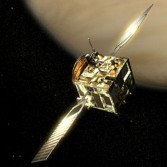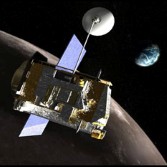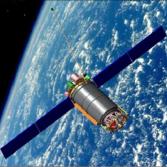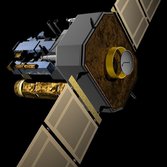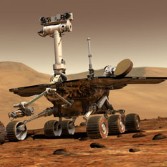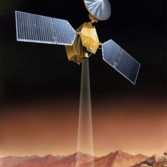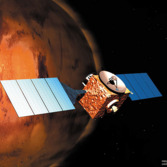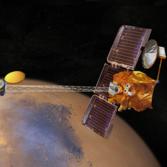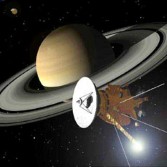Emily Lakdawalla • Jan 04, 2010
What's up in the solar system in January 2010
EDIT Jan 8: Corrected the entry on the status of Spirit; extrication efforts continue.
EDIT Jan 6: Corrected the launch date of Akatsuki (to July) and Hartley 2 encounter date of Deep Impact (to November).
2010! Wow. Here we are. Where's my Moon base?
While we don't have Moon bases, we do have plenty of spacecraft. Before I get into my more detailed look at the activities of the 20-odd spacecraft wandering about the solar system, I thought I'd look ahead to 2010 more generally and see what the year has in store for us.
The thing that will probably be weighing most on people's minds this year is the fact that 2010 is planned to be the very last year of Space Shuttle flights, with five launches to the International Space Station. There will probably be much discussion about what will happen to the Shuttles after their last flights. Currently, Atlantis' last flight will be in May; Endeavour's last flight will be in July; and Discovery's last flight is planned for September. Of course these dates are subject to change.
It's a relatively light year for solar system launches: there will be just three. NASA's Solar Dynamics Observatory goes up in February, JAXA's Venus orbiter Akatsuki in July and the second Chinese lunar orbiter in October. Sharing Akatsuki's launch vehicle will be IKAROS (Interplanetary Kite-craft Accelerated by Radiation Of the Sun), something that The Planetary Society will be watching closely because, of course, we are just a little bit interested in solar sailing! Our own LightSail will be built and ready for launch this year as well.
I'm sure 2010 will contain its share of major announcements of discoveries from ongoing missions to all parts of the solar system. But, looking at the calendar, the big events that we can predict all seem to have to do with the solar system's smallest bodies. In June, we can look forward to Hayabusa's return of its sample capsule to Earth -- let's hope it contains at least a few tiny grains of material from asteroid Itokawa! In July, Rosetta will fly past asteroid 21 Lutetia, which should be quite interesting, as Lutetia will be the largest asteroid ever visited by a spacecraft (at roughly 100 kilometers in diameter, it's similar in size to Saturn's moon Epimetheus). And on November 4, Deep Impact will fly past comet 103P/Hartley 2.
So 2010 will be the year of the Asteroids and Comets, for sure. Now to check out what's going on right now with all the active solar system explorers. I don't have any events on my calendar for active spacecraft this month. January is, however, the 400th anniversary of Galileo's discovery of Jupiter's moons. So happy birthday to Io, Europa, Ganymede, and Callisto! Because of course they didn't exist until we could observe them, right? Also, expect a bunch of press releases this week, as the 215th meeting of the American Astronomical Society is going on in Washington.
In the Inner Solar System
The MESSENGER spacecraft is cruising along. Mercury orbit insertion is planned for March 18, 2011. They're preparing for the orbital mission by composing and releasing the first global map of Mercury.
Venus Express remains healthy (as of November 14) in orbit at Venus. Its current mission extension runs through 2012. Last month, they released another big pile of data to the Planetary Science Archive.
Lunar Reconnaissance Orbiter is busily mapping the Moon from its science orbit. Last month they released a map of seriously cold north polar winter temperatures from Diviner. Meanwhile, the camera team announced a "prerelease" of data to the Planetary Data System. Data! I love data! But I just haven't had time! Go explore the 700 images they prereleased -- but make sure you bring a big hard drive. Of their recent captioned image releases, my favorite is this one showing bright debris streamers cascading down a crater wall.
At the Sun
Mea culpa: in my past roundups I have totally been forgetting Koronas-Foton, a Russian solar observatory. It was launched in January 30. They actually prematurely lost contact with the spacecraft last month but have recontacted it, and should be able to update the world on its condition and whether problems with its power systems will permit its mission to continue, next week.
Current images from the ESA/NASA SOHO mission show a very bright "sungrazing" comet in the field of view. According to spaceweather.com, the poor thing is now toast. As always, SOHO's near-real-time data and images are available here.
The twin STEREO spacecraft are showing us a Sun that is starting to increase in activity as the new solar cycle begins. The daily STEREO image viewer shows that sunspot 1039 is rotating out of view from Earth but that we'll soon see coming into view a huge cluster of sunspots in the northern hemisphere. Should be fun.
On to Mars
Out at Mars, it's mid southern hemisphere autumn (Ls 33°). Today it is Spirit sol 2135 and Opportunity sol 2115. The Mars Exploration Rover mission is now acknowledging they may have to end extrication efforts to focus on improving Spirit's chances of winter survival, but for now, extrication efforts continue. If they do stop rolling for the winter, they actually have a lot of ideas for valuable science that can be done with Spirit at her current position. Opportunity is still parked at Marquette Island, which now appears to be a treasure trove: a rock excavated from deep within Mars by an impact. In A. J. S. Rayl's latest rover update, Steve Squyres calls it the coolest and oldest Martian rock Opportunity has found on the whole mission, with the possible exception of Bounce Rock.
Mars Reconnaissance Orbiter is, at last, out of safe mode and fully returned to science operations; I'm sure the rover teams are delighted to have their weather reports back from the MARCI instrument. Lately MARCI has been observing a dust storm "raging" across the northern hemisphere; good thing the rovers are south of the equator! It doesn't look like the HiRISE team has gotten images since the return to science operations through their processing pipeline yet, but some of the goodies they're currently releasing from before the safing event include several new pics of the area in which Mars Polar Lander disappeared.
ESA's Mars Express is still diligently mapping Mars. The Mars Webcam is currently returning mostly high-phase shots of Mars, but there have been some really cool lower-altitude sequences where Mars totally fills the frame. For the next few months, VMC images will be downlinked more rapidly than normal, meaning that in some cases, VMC images appear on the Web within hours of their capture on the spacecraft! You can learn more about how to process VMC images using this tutorial.
NASA's Mars Odyssey remains the longest-lived spacecraft in orbit at Mars. You can see the latest from its THEMIS instrument here. Check out the awesome streamlined islands in this photo -- smoking guns for water flowing on the surface of ancient Mars. In addition to doing science, Odyssey continues to relay almost all of the data from Spirit and Opportunity back to Earth.
Exploring Saturn
Cassini is kicking off the last year of its extended mission. Hopefully we'll hear soon that the mission has been extended again, this time for a further seven years. The plans for the Cassini "XXM" (extended-extended mission) have been in the works for some time, but NASA has not officially given the thumbs up yet. This month contains two targeted flybys of Titan, plus a passel of more distant flybys near orbit periapsis, on January 27: Dione, Telesto, Methone, Pan, and Prometheus, according to JPL's space events calendar. Rev 124 starts today, and rev 125 on January 19; both are 16 days long, the same period as Titan's orbit. The inclination is low, close to the ring plane, permitting occasional decent views of icy moons, but in between the two Titan flybys the inclination will be a bit higher, setting up the geometry that will allow a spectacular radio occultation experiment, observing fine structure within Saturn's rings from one ansa to the other, on rev 125. Cool. Cassini's orbit apoapsis remains at a fairly high phase of 103°, which means that the global shots of Saturn will show it as a pretty, fat crescent. Other activities in Rev 124 include capturing movies of spokes in Saturn's B ring, capturing RADAR views across Ontario Lacus (one of the few fluid-filled lakes in Titan's south); and what sound like really cool mutual-event observations of Janus and Epimetheus, which are in the middle of their biennial orbital swap dance. These and more activities are explained in great detail in Jason Perry's rev 124 "Looking Ahead" article for CICLOPS.
Quietly Cruising
ESA's Rosetta is cruising along toward its May 2014 rendezvous with comet Churyumov-Gerasimenko. There will be one deep-space maneuver in January 2011. The next big science event for Rosetta will be a flyby of asteroid Lutetia in July of this year.
The International Cometary Explorer remains on course for a return visit to Earth in 2014. When it does, ICE can be returned to a Sun-Earth L1 halo orbit, or can use multiple Earth swingbys to encounter Comet Wirtanen during its near-Earth apparition in December 2018.
NASA's Deep Impact is cruising toward its November flyby of comet 103P/Hartley 2.
NASA's Stardust is cruising ever onward toward a February 14, 2011 encounter with comet Tempel 1. The December status reports indicate the spacecraft is in good health.
As I reported recently, Hayabusa is still on track to return to Earth in June 2010; the latest status report indicates all is well, and that they expect to start noticing Earth's gravity affecting the spacecraft's trajectory next week.
NASA's New Horizons has 16.35 AU to go to reach Pluto; it is now -- and will be, for as long as New Horizons is an active mission -- closer to Pluto than it is to Earth. It's still on course for a January to July 2015 encounter with the Pluto and Charon system. Just now the spacecraft is awake, doing some system maintenance; when it hibernates again on January 13 it'll remain asleep until May.
And Beyond
Finally, NASA's Voyager 1 and 2 spacecraft were still responding to commands from Earth as of October 16. Both have now crossed the "termination shock," where the solar wind slows down as it impinges upon the interstellar medium.
Some other milestones to take note of this month, taken mostly from JPL's Space Calendar:
- Earth just passed through perihelion today (January 4). Our orbit isn't too elliptical, but the fact that perihelion occurs so close to the solstice means that northern hemisphere winters are moderated a bit by the Sun being just a bit warmer; southern hemisphere summers are hotter than they'd otherwise be.
- Mars is at opposition on January 29, and makes its closest approach to Earth the day before, on the 28th. Check Spaceweather Flash for some nice amateur Mars images.
Support our core enterprises
Your support powers our mission to explore worlds, find life, and defend Earth. You make all the difference when you make a gift. Give today!
Donate

 Explore Worlds
Explore Worlds Find Life
Find Life Defend Earth
Defend Earth



